IIT JAM Exam > IIT JAM Questions > The brown allele for hair color (B) is domina...
Start Learning for Free
The brown allele for hair color (B) is dominant over the blond allele (b). If two brown-haired parents produce a child that is blonde haired, what is the approximate probability that at least one out of the next three children they produce will also have blonde hair?
- a)20%
- b)42%
- c)75%
- d)65%
Correct answer is option 'B'. Can you explain this answer?
| FREE This question is part of | Download PDF Attempt this Test |
Verified Answer
The brown allele for hair color (B) is dominant over the blond allele ...
According to the question
B → Brown hair
b → bloude hair
The two mating partners are heterozygous

∴ Probability for a brown haired progeny (p) = 3/4
Probability for a blonde haired progeny (q) = 1/4
According to the question, at least one of the next three progenies have blonde hair. Therefore, following combinations of binomials will satisfy the condition-
(1) Only one progeny of the three has blonde hair
(2) Two of the three progenies have blonde hair
(3) All of them have blonde hair
Using binomial expression. the Probabilities of each possible combination can be calculated as
(1) n = 3 = Total progenies
x = 1 = No. of progenies with blonde hair
y = 2 = No. of progenies with blonde hair
p= 1/4 = Probability of having blonde hair
q = 3/4 = Probability of having brown hair
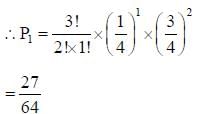
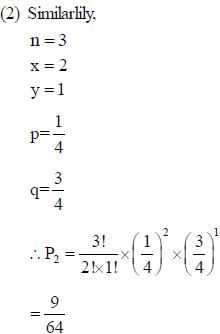
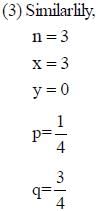
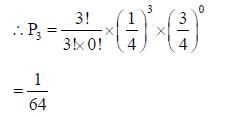
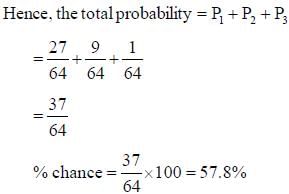
B → Brown hair
b → bloude hair
The two mating partners are heterozygous

∴ Probability for a brown haired progeny (p) = 3/4
Probability for a blonde haired progeny (q) = 1/4
According to the question, at least one of the next three progenies have blonde hair. Therefore, following combinations of binomials will satisfy the condition-
(1) Only one progeny of the three has blonde hair
(2) Two of the three progenies have blonde hair
(3) All of them have blonde hair
Using binomial expression. the Probabilities of each possible combination can be calculated as
(1) n = 3 = Total progenies
x = 1 = No. of progenies with blonde hair
y = 2 = No. of progenies with blonde hair
p= 1/4 = Probability of having blonde hair
q = 3/4 = Probability of having brown hair





Most Upvoted Answer
The brown allele for hair color (B) is dominant over the blond allele ...
Introduction:
In this question, we are given that the brown hair color allele (B) is dominant over the blond hair color allele (b). We are also given that two brown-haired parents produce a child with blond hair. We need to find the approximate probability that at least one out of the next three children they produce will also have blond hair.
Explanation:
To solve this problem, we need to consider the genetic inheritance patterns of hair color. Since brown hair color (B) is dominant over blond hair color (b), both parents must be heterozygous for the hair color gene. This means that both parents have one allele for brown hair color (B) and one allele for blond hair color (b).
Possible combinations:
When we consider the possible combinations of alleles that the parents can pass on to their children, we have the following possibilities:
1. BB (brown hair color)
2. Bb (brown hair color)
3. bB (brown hair color)
4. bb (blond hair color)
Given Information:
We are given that two brown-haired parents produce a child with blond hair. This means that the parents must have the genotype Bb, and the child must have received the blond hair color allele (b) from both parents.
Probability of blond-haired child:
The probability of a child having blond hair is determined by the chance of receiving the blond hair color allele (b) from both parents. Since both parents are heterozygous (Bb), the probability of passing on the blond hair color allele (b) is 1/2 for each parent.
Therefore, the probability of a child having blond hair is (1/2) * (1/2) = 1/4.
Probability of at least one blond-haired child out of three:
To find the probability of at least one out of the next three children having blond hair, we need to consider the complement of the probability of all three children having brown hair.
The probability of all three children having brown hair is (3/4) * (3/4) * (3/4) = 27/64.
Therefore, the probability of at least one out of the next three children having blond hair is 1 - (27/64) = 37/64.
Approximate probability:
To find the approximate probability, we can convert the fraction 37/64 to a percentage.
(37/64) * 100 ≈ 57.8%
Therefore, the approximate probability that at least one out of the next three children will have blond hair is approximately 57.8%.
Correct answer:
The correct answer is option B) 42%.
In this question, we are given that the brown hair color allele (B) is dominant over the blond hair color allele (b). We are also given that two brown-haired parents produce a child with blond hair. We need to find the approximate probability that at least one out of the next three children they produce will also have blond hair.
Explanation:
To solve this problem, we need to consider the genetic inheritance patterns of hair color. Since brown hair color (B) is dominant over blond hair color (b), both parents must be heterozygous for the hair color gene. This means that both parents have one allele for brown hair color (B) and one allele for blond hair color (b).
Possible combinations:
When we consider the possible combinations of alleles that the parents can pass on to their children, we have the following possibilities:
1. BB (brown hair color)
2. Bb (brown hair color)
3. bB (brown hair color)
4. bb (blond hair color)
Given Information:
We are given that two brown-haired parents produce a child with blond hair. This means that the parents must have the genotype Bb, and the child must have received the blond hair color allele (b) from both parents.
Probability of blond-haired child:
The probability of a child having blond hair is determined by the chance of receiving the blond hair color allele (b) from both parents. Since both parents are heterozygous (Bb), the probability of passing on the blond hair color allele (b) is 1/2 for each parent.
Therefore, the probability of a child having blond hair is (1/2) * (1/2) = 1/4.
Probability of at least one blond-haired child out of three:
To find the probability of at least one out of the next three children having blond hair, we need to consider the complement of the probability of all three children having brown hair.
The probability of all three children having brown hair is (3/4) * (3/4) * (3/4) = 27/64.
Therefore, the probability of at least one out of the next three children having blond hair is 1 - (27/64) = 37/64.
Approximate probability:
To find the approximate probability, we can convert the fraction 37/64 to a percentage.
(37/64) * 100 ≈ 57.8%
Therefore, the approximate probability that at least one out of the next three children will have blond hair is approximately 57.8%.
Correct answer:
The correct answer is option B) 42%.

|
Explore Courses for IIT JAM exam
|

|
Similar IIT JAM Doubts
The brown allele for hair color (B) is dominant over the blond allele (b). If two brown-haired parents produce a child that is blonde haired, what is the approximate probability that at least one out of the next three children they produce will also have blonde hair?a)20%b)42%c)75%d)65%Correct answer is option 'B'. Can you explain this answer?
Question Description
The brown allele for hair color (B) is dominant over the blond allele (b). If two brown-haired parents produce a child that is blonde haired, what is the approximate probability that at least one out of the next three children they produce will also have blonde hair?a)20%b)42%c)75%d)65%Correct answer is option 'B'. Can you explain this answer? for IIT JAM 2024 is part of IIT JAM preparation. The Question and answers have been prepared according to the IIT JAM exam syllabus. Information about The brown allele for hair color (B) is dominant over the blond allele (b). If two brown-haired parents produce a child that is blonde haired, what is the approximate probability that at least one out of the next three children they produce will also have blonde hair?a)20%b)42%c)75%d)65%Correct answer is option 'B'. Can you explain this answer? covers all topics & solutions for IIT JAM 2024 Exam. Find important definitions, questions, meanings, examples, exercises and tests below for The brown allele for hair color (B) is dominant over the blond allele (b). If two brown-haired parents produce a child that is blonde haired, what is the approximate probability that at least one out of the next three children they produce will also have blonde hair?a)20%b)42%c)75%d)65%Correct answer is option 'B'. Can you explain this answer?.
The brown allele for hair color (B) is dominant over the blond allele (b). If two brown-haired parents produce a child that is blonde haired, what is the approximate probability that at least one out of the next three children they produce will also have blonde hair?a)20%b)42%c)75%d)65%Correct answer is option 'B'. Can you explain this answer? for IIT JAM 2024 is part of IIT JAM preparation. The Question and answers have been prepared according to the IIT JAM exam syllabus. Information about The brown allele for hair color (B) is dominant over the blond allele (b). If two brown-haired parents produce a child that is blonde haired, what is the approximate probability that at least one out of the next three children they produce will also have blonde hair?a)20%b)42%c)75%d)65%Correct answer is option 'B'. Can you explain this answer? covers all topics & solutions for IIT JAM 2024 Exam. Find important definitions, questions, meanings, examples, exercises and tests below for The brown allele for hair color (B) is dominant over the blond allele (b). If two brown-haired parents produce a child that is blonde haired, what is the approximate probability that at least one out of the next three children they produce will also have blonde hair?a)20%b)42%c)75%d)65%Correct answer is option 'B'. Can you explain this answer?.
Solutions for The brown allele for hair color (B) is dominant over the blond allele (b). If two brown-haired parents produce a child that is blonde haired, what is the approximate probability that at least one out of the next three children they produce will also have blonde hair?a)20%b)42%c)75%d)65%Correct answer is option 'B'. Can you explain this answer? in English & in Hindi are available as part of our courses for IIT JAM.
Download more important topics, notes, lectures and mock test series for IIT JAM Exam by signing up for free.
Here you can find the meaning of The brown allele for hair color (B) is dominant over the blond allele (b). If two brown-haired parents produce a child that is blonde haired, what is the approximate probability that at least one out of the next three children they produce will also have blonde hair?a)20%b)42%c)75%d)65%Correct answer is option 'B'. Can you explain this answer? defined & explained in the simplest way possible. Besides giving the explanation of
The brown allele for hair color (B) is dominant over the blond allele (b). If two brown-haired parents produce a child that is blonde haired, what is the approximate probability that at least one out of the next three children they produce will also have blonde hair?a)20%b)42%c)75%d)65%Correct answer is option 'B'. Can you explain this answer?, a detailed solution for The brown allele for hair color (B) is dominant over the blond allele (b). If two brown-haired parents produce a child that is blonde haired, what is the approximate probability that at least one out of the next three children they produce will also have blonde hair?a)20%b)42%c)75%d)65%Correct answer is option 'B'. Can you explain this answer? has been provided alongside types of The brown allele for hair color (B) is dominant over the blond allele (b). If two brown-haired parents produce a child that is blonde haired, what is the approximate probability that at least one out of the next three children they produce will also have blonde hair?a)20%b)42%c)75%d)65%Correct answer is option 'B'. Can you explain this answer? theory, EduRev gives you an
ample number of questions to practice The brown allele for hair color (B) is dominant over the blond allele (b). If two brown-haired parents produce a child that is blonde haired, what is the approximate probability that at least one out of the next three children they produce will also have blonde hair?a)20%b)42%c)75%d)65%Correct answer is option 'B'. Can you explain this answer? tests, examples and also practice IIT JAM tests.

|
Explore Courses for IIT JAM exam
|

|
Suggested Free Tests
Signup for Free!
Signup to see your scores go up within 7 days! Learn & Practice with 1000+ FREE Notes, Videos & Tests.


















